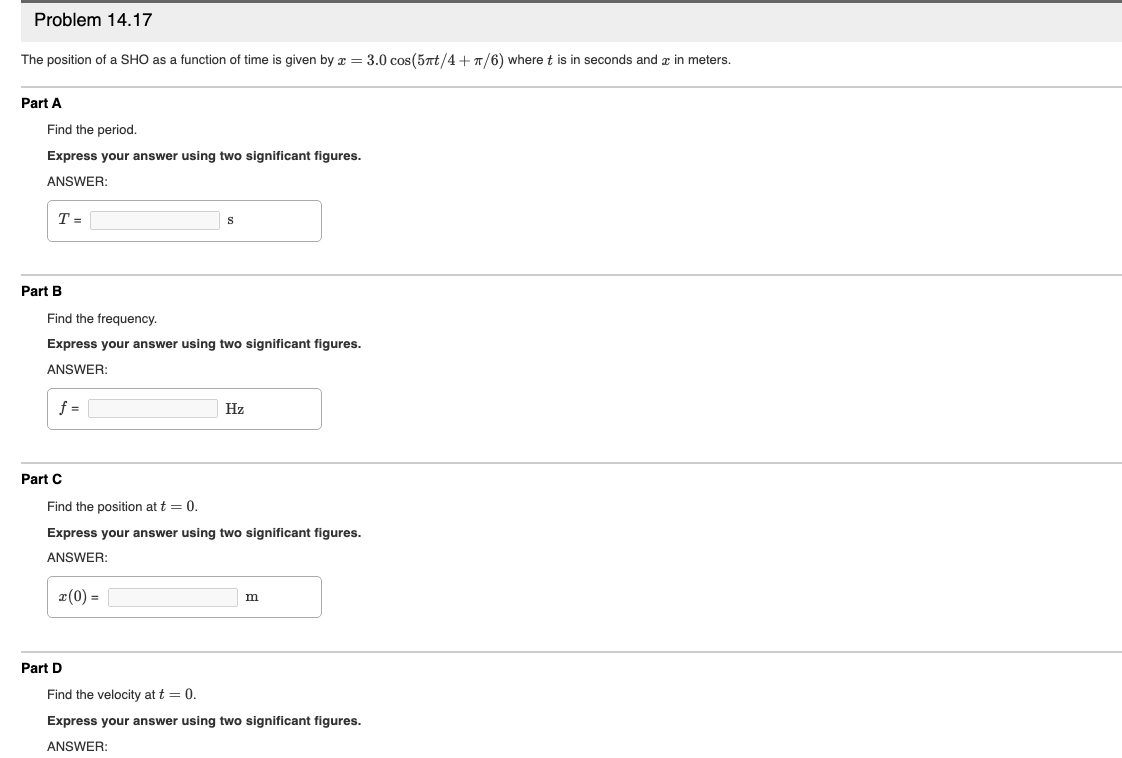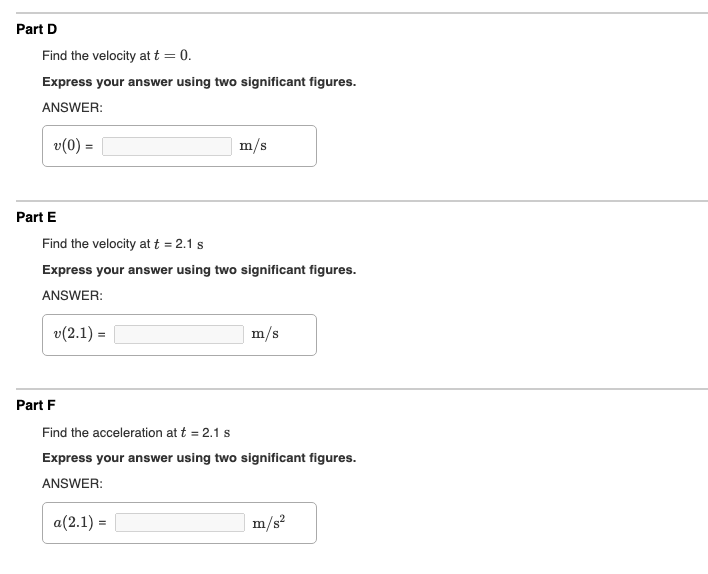The position of a SHO as a function of time is given by x = 3.0 cos(5at/4 + T/6) where t is in seconds and æ in meters. Part A Find the period. Express your answer using two significant figures. ANSWER: T = Part B Find the frequency. Express your answer using two significant figures. ANSWER: f = Hz Part C Find the position at t = 0. Express your answer using two significant figures. ANSWER: ¤(0) = m
The position of a SHO as a function of time is given by x = 3.0 cos(5at/4 + T/6) where t is in seconds and æ in meters. Part A Find the period. Express your answer using two significant figures. ANSWER: T = Part B Find the frequency. Express your answer using two significant figures. ANSWER: f = Hz Part C Find the position at t = 0. Express your answer using two significant figures. ANSWER: ¤(0) = m
Principles of Physics: A Calculus-Based Text
5th Edition
ISBN:9781133104261
Author:Raymond A. Serway, John W. Jewett
Publisher:Raymond A. Serway, John W. Jewett
Chapter12: Oscillatory Motion
Section: Chapter Questions
Problem 3P: The position of a particle is given by the expression x = 4.00 cos {3.00 t + }, where x is in meters...
Related questions
Question
Please help me with all the parts, this is to study so I want to have all the parts to study.

Transcribed Image Text:Problem 14.17
The position of a SHO as a function of time is given by x = 3.0 cos(5at/4+ T/6) where t is in seconds and x in meters.
Part A
Find the period.
Express your answer using two significant figures.
ANSWER:
T =
S
Part B
Find the frequency.
Express your answer using two significant figures.
ANSWER:
f =
Hz
Part C
Find the position at t = 0.
Express your answer using two significant figures.
ANSWER:
æ(0) =
m
Part D
Find the velocity at t = 0.
Express your answer using two significant figures.
ANSWER:

Transcribed Image Text:Part D
Find the velocity at t = 0.
Express your answer using two significant figures.
ANSWER:
v(0) =
m/s
Part E
Find the velocity at t = 2.1 s
Express your answer using two significant figures.
ANSWER:
v(2.1) =
m/s
Part F
Find the acceleration at t = 2.1 s
Express your answer using two significant figures.
ANSWER:
a(2.1) =
m/s?
Expert Solution
This question has been solved!
Explore an expertly crafted, step-by-step solution for a thorough understanding of key concepts.
This is a popular solution!
Trending now
This is a popular solution!
Step by step
Solved in 4 steps

Knowledge Booster
Learn more about
Need a deep-dive on the concept behind this application? Look no further. Learn more about this topic, physics and related others by exploring similar questions and additional content below.Recommended textbooks for you

Principles of Physics: A Calculus-Based Text
Physics
ISBN:
9781133104261
Author:
Raymond A. Serway, John W. Jewett
Publisher:
Cengage Learning

College Physics
Physics
ISBN:
9781938168000
Author:
Paul Peter Urone, Roger Hinrichs
Publisher:
OpenStax College

Physics for Scientists and Engineers, Technology …
Physics
ISBN:
9781305116399
Author:
Raymond A. Serway, John W. Jewett
Publisher:
Cengage Learning

Principles of Physics: A Calculus-Based Text
Physics
ISBN:
9781133104261
Author:
Raymond A. Serway, John W. Jewett
Publisher:
Cengage Learning

College Physics
Physics
ISBN:
9781938168000
Author:
Paul Peter Urone, Roger Hinrichs
Publisher:
OpenStax College

Physics for Scientists and Engineers, Technology …
Physics
ISBN:
9781305116399
Author:
Raymond A. Serway, John W. Jewett
Publisher:
Cengage Learning

College Physics
Physics
ISBN:
9781285737027
Author:
Raymond A. Serway, Chris Vuille
Publisher:
Cengage Learning


University Physics Volume 1
Physics
ISBN:
9781938168277
Author:
William Moebs, Samuel J. Ling, Jeff Sanny
Publisher:
OpenStax - Rice University